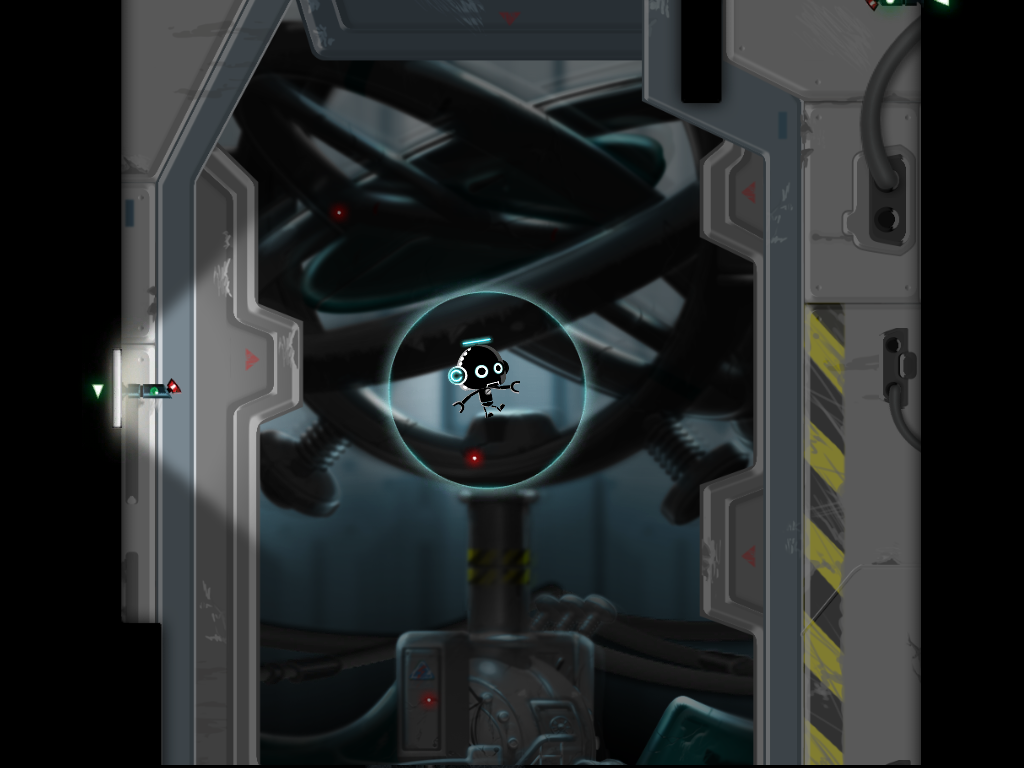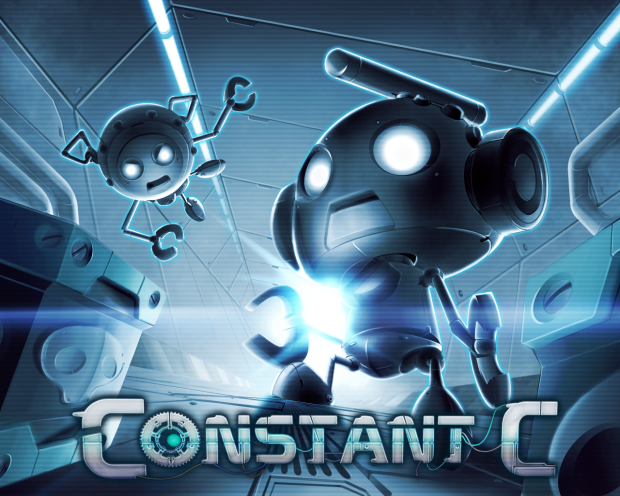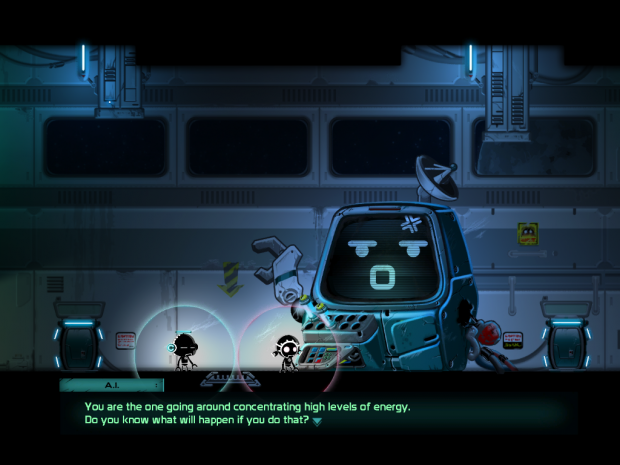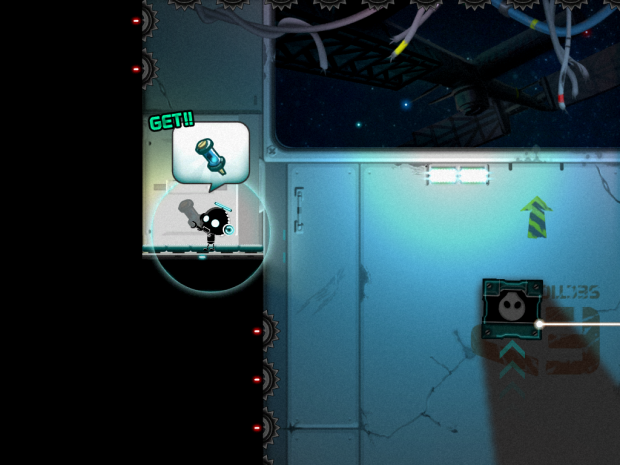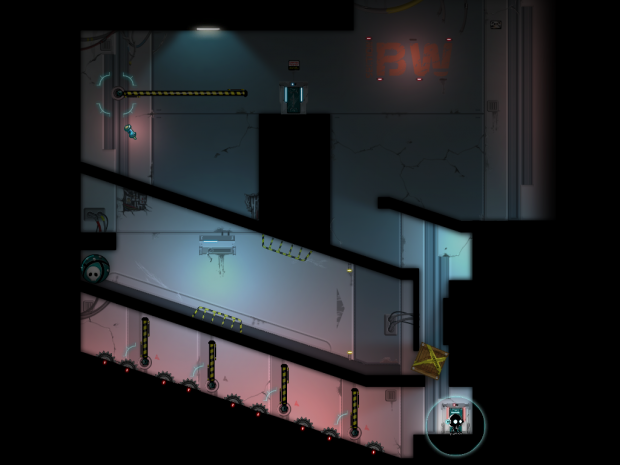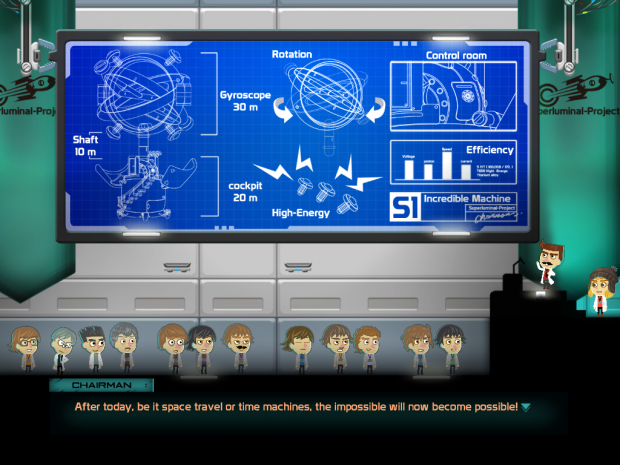Constant C preview: Head spin
Constant C is mixes time, space and gravity gameplay mechanics into a physics-based puzzle-platformer. It’s headed to Xbox Live Arcade next week, but we’ve already played it extensively and spoken with one of its three creators.
So what exactly is “Constant C”? Light Wang of Taiwan-based developer International Games System Co. (IGS) tells XBLA Fans that the title comes from “the equation of mass–energy equivalence [which] is E = MC2. Constant C is the speed of light.”
In the game, scientists were trying to break the speed of light, but accidentally stopped the flow of time instead. As a result, all objects are frozen in time except for on-board artificial intelligences, such as the player character.
Time stops for no one — except you
Shortly after the accident, you wake up to find the space station in temporal suspension. After some wandering, you are greeted by the highly expressive emoticon-faced AI Control Platform. Wang compares the AI to GLaDOS from Portal. Luckily, he is much less evil — but just as sarcastic. According to the AI, you need to figure out exactly what happened to the space station before you can restore ordinary time flow. To do this, you must pick up data storage devices scattered throughout the station.
Each room of the space station is a puzzle with blocks, hazards and structures, and acquiring the aforementioned storage devices is the goal of each room. To pick one up, you actually have to stand next to it for two seconds, meaning you can’t just fling yourself past it to pick it up before dying. This requires you to manipulate blocks and platforms around so you can comfortably pick up the devices.
Doing so isn’t easy, because time is stopped except around you, which means that objects frozen in time become unfrozen as soon as you get close to them. A massive block above you will come crashing down if your emanating time field touches it. It’s very easy to be taken off-guard by the sudden changes that your time field triggers, as you won’t see them coming until they’re, well, coming.
What goes up…
Early on in the game you also pick up the ability to change gravity. The A button jumps and X, Y and B shift gravity in their respective directions. Again, objects stay in place until you come near them, so you can approach a sitting block, switch gravity and fall with it to move it around. Once you break contact, the object will stay in place even as you rotate gravity, not to move again until you return to contact. What’s really cool is that objects will keep their momentum (indicated by arrows in the screenshot below) if you break time-contact in motion, helping you to steer objects across different gravity directions.
If that last paragraph sounds confusing, that’s because it is. Constant C is one of the most spatially perplexing puzzle games you may ever play. Even the straightforward gravity-switching takes getting used to. It’s easy to forget that any wall blocking your path becomes a floor at the press of a button. How did the folks at IGS even make puzzles around these ideas?
“We experimented a lot,” Wang admits. “Sometimes when we got a[n] idea, we built it and tested it out. Sometimes we just played around with all the different objects in the game to see what would happen when they interacted with each other. We even tried putting the player in impossible circumstances to try to solve it ourselves.”
And try you must, as most attempts will end up in smoking failure. Though your robot is a machine, he is still quite fragile and cannot withstand a drop more than four times his height. With all the topsy-turvy gravity switching, it is very easy to fall too far and die in a scorching explosion. Apparently, our little service robot isn’t designed for heavy stunts. But, Wang argues, “If there was no fall damage, the player could just fly around freely. That would make the puzzles a little too easy, don’t you think?”
…Must come down
Interestingly, Constant C was originally meant to be a side-scrolling game solely about switching gravity, but it came with a problem. “If players [could] switch gravity too freely, all the objects in the level would fly around and create a total mess,” Wang explains. “At that time one of our team members was playing the game called Closure. We then got to thinking – what if just like in Closure, the gravity only affects the objects around our character? We experimented with it and all the puzzle ideas just came flooding in. Then we knew we were on the right track.”
Constant C also owes some of its inspiration to other well-known indie games. Wang mentions Super Meat Boy and Limbo, the latter of which featured a similar gravity-swapping mechanic. Wang also drew ideas from Braid, admitting to us, “Braid was the game that made me become a game developer in the first place.”
Still, Constant C carries its own personal charm. The derelict, frozen space station silently screams a foreboding stillness akin to Super Metroid. What’s really cool is that the time field is more than a gameplay mechanic — it affects the environment, too. A broken wire will shoot sparks out as you pass by, but those sparks will freeze in mid-air as soon as your time field breaks contact. Background machines whir and buzz with life next you, but they stop in place behind you. Little touches like this add a tangible eeriness to the cartoonish setting of Constant C. Everything feels frozen in time, as it should.
The best part, however, is the music. Composer and sound designer Chen-Ping Ling has crafted a spunky, dynamic soundtrack that punctuates daring challenge with ominous curiosity. It’s one of those soundtracks that compels you to stop and listen before walking through the door so you can hear what beats will come next.
Brutally charming or charmingly brutal?
These charms are important, because Constant C is a brutal game. Wang offers a bit of advice to players: “Be patient. Try many different ways and observe your surroundings. If you get stuck on one level for too long, skip it or just stand up and walk around a bit. If you tried something again and again but it still doesn’t work, that usually means you are not on the right track! Experiment as much as you can. In the name of Science!”
Each time you die (which will be many), scorch marks on the walls remind you where you did something wrong. You will be surprised how many scorch marks will build up in the exact same place from multiple tries. We wanted to know if the marks left behind meant there were multiple robots, or if we were witnessing some sort of time-space paradox.
“Anything is possible in a time distorted space station!” Wang dodges. “We wanted to create some positive feedback from our players dying. Dying and learning is a very important aspect for Constant C.”
Of course, we couldn’t let Wang get away without asking our most frequent question this year: will the game come to Xbox One?
“We are considering it.”
My fingers are crossed, because Constant C has made me consider the possibilities when time flow and gravity become a not-so-constant.

